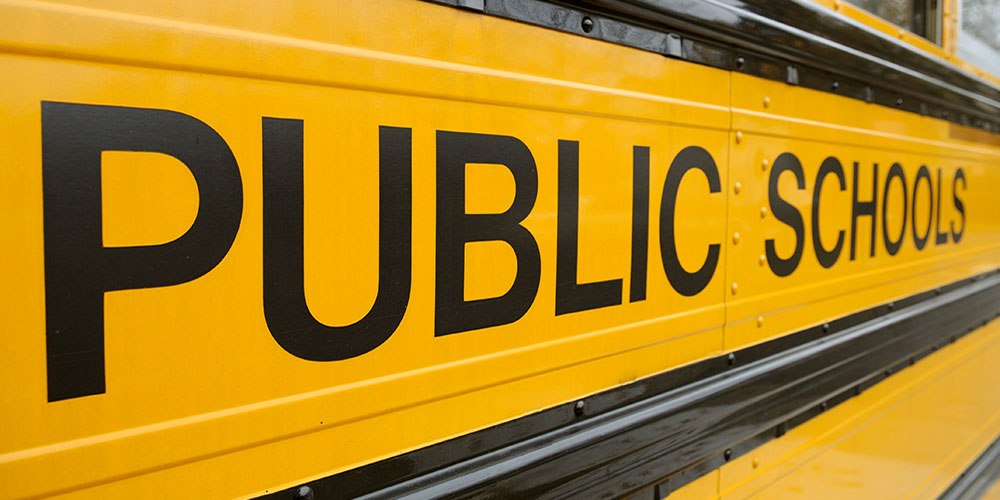This article, originally published May 17, 2023, has been updated to include new data findings.
Between 2013 and 2019, the percentage of students enrolled in public schools rose steadily as the U.S. population grew from 316.1 million to 328.3 million. Once the pandemic hit, enrollment numbers fell by more than a million. From fall 2019 to fall 2020, the number of students enrolled in U.S. public elementary and secondary schools dropped from 50.8 million to 49.4 million, according to the National Center for Education Statistics (NCES).
Once public elementary and secondary schools reopened for in-person learning at some point in 2021, enrollment jumped back up to around 50.1 million. However, in 2023, the number fell back down to 49.7 million, which is still 2.09% below pre-pandemic levels, according to Scholaroo. The data is depicted in the graph below.
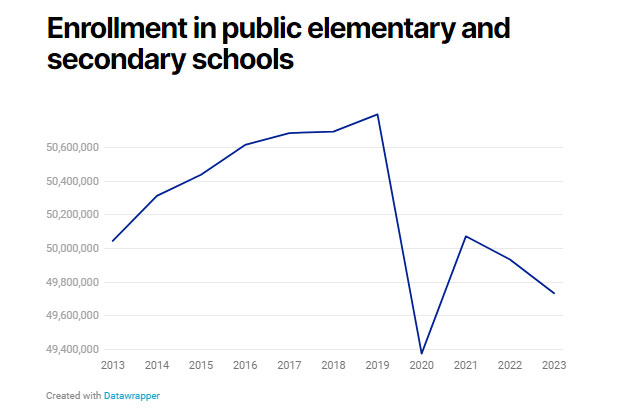
Source: Scholaroo
This significant drop in public school enrollment raises several important questions:
- Why does it matter?
- Where did all those students go?
- Why did they leave the public school system?
Why Does the Public School Enrollment Decline Matter?
While there are countless reasons why the drop in enrollment is concerning, one of the most obvious is that public schools lose funding as they lose students. For instance, in Massachusetts, school funding is primarily based on a per-pupil allotment each school district receives — i.e. the higher the number of students, the more state and local funding it receives.
“You will have to struggle with balanced budgets as student numbers decline,” Glenn Koocher, executive director for the Massachusetts School Committees Association, told Mass Live. “It is the educational story since the beginning of time.”
Los Angeles Unified School District Superintendent Alberto Carvalho told The 74 that the district saw a 5.9% decline during the 2021-2022 school year. Of the 10 largest school districts in the U.S., eight have seen a decline in enrollment each year from 2018 to 2022, as depicted in the graph below. A Wall Street Journal analysis found enrollment fell in roughly 85 of the nation’s 100 largest public school districts.
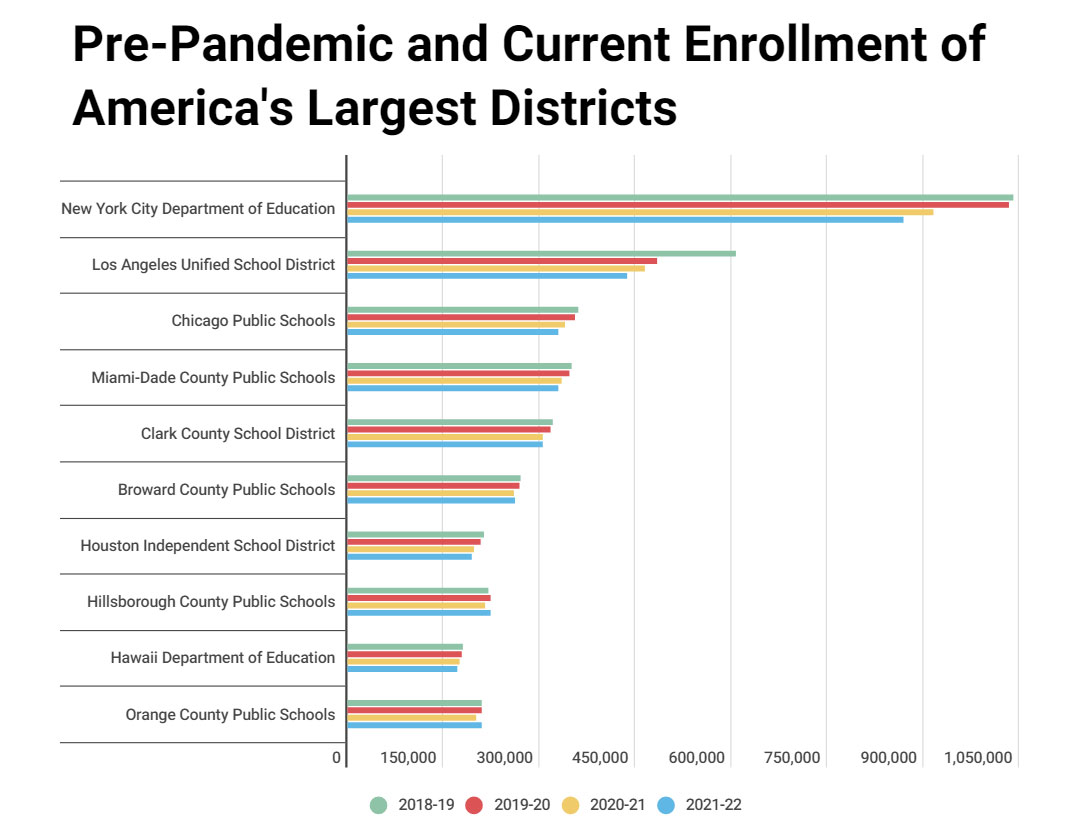
Source: The 74
The current teacher shortage is exacerbated by the enrollment decline since less funding for schools means less money available to hire new teachers or offer better pay to current ones. Many schools and districts are currently relying on federal COVID relief funds to address this problem, but what happens when those funds run out?
Carvalho was asked what would happen to the district if it didn’t turn enrollment trends around by the time federal relief funds dry up in 2024.
“Armageddon,” he responded. “It’s going to be a hurricane of massive proportions.”
The exodus from public schools has also forced some schools to close altogether which has disproportionately impacted lower-income families, many of whom can’t consider alternative schooling such as private or charter schools, further widening the class divide.
The trend is also widening the divide between urban and rural students due to accessibility. According to the Brookings Institution, 92% of people who live in urban areas live within five miles of a private school while only 34% of people who live in rural areas have a private school within the same radius.
Where Did the Students Go?
Researchers from Stanford University found that 14% of students disenrolled from public schools between fall 2019 through spring 2022 went to private schools and 26% switched to homeschooling.
In 2019, the last time official data was collected by NCES on private school enrollment, around 4.7 million K-12 students (9% of all K-12 students) were enrolled in private schools, which was not measurably different from the number enrolled in the fall of 2009. However, since the pandemic, private schools have reported an increase in enrollment.
During the 2020-2021 school year, 35% of private schools reported an increase in enrollment, according to CATO. Comparatively, 26.5% reported a decrease and 38.2% reported no change.
A subsequent CATO study found that 55% of private schools reported enrollment increases between the 2021-2022 school year and the 2022-2023 school year. Twenty percent saw decreases and 25% reported no change. The average change was around 10 students per school which is about a 5% increase from the 2019-2020 average. Nearly half also reported having more applicants than available openings.
Charter schools pulled many students away from public schools during and after the pandemic. During the 2020-2021 school year, 7.5% of all public school students were enrolled in charter schools, up from 6.8% in 2019-2020, says the National Alliance for Public Charter Schools.
Enrollment in New York City Public Schools, the country’s largest school district, dropped drastically from 2018 to 2022 (as seen in the previous The 74 graph). During the same period, enrollment in NYC charter schools increased by around 7.8%, according to the New York City Independent Budget Office. In Alabama and Oklahoma, charter school enrollment increased by a whopping 65% and 78%, respectively.
Here’s a breakdown of charter school enrollment change by state from academic years 2020 to 2021:
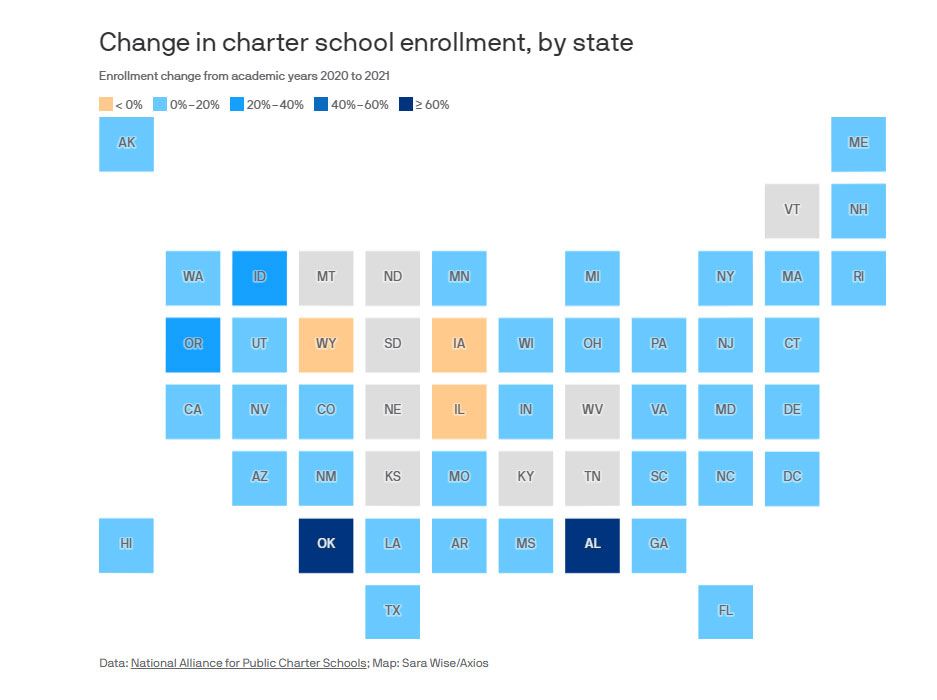
Homeschooling also increased significantly during and after the pandemic. A 2021 report from the Bellwether Education Partners, commissioned by the Walton Family Foundation, found nearly 2.6 million kids have switched from traditional school to homeschooling since the start of the pandemic, placing the total number of homeschooled kids at about five million — around 11% of all U.S. households.
A similar survey conducted by Q for Quinn found in addition to 11% of parents currently homeschooling their children, an additional 15% said they plan to transition to homeschooling in the near future. Below are the nine states with the largest percentage of homeschooled children.

Source: Q for Quinn
Why Are Parents Pulling Kids from Public Schools?
Some parents turned to charter or private schools during the pandemic since they can make their own rules. During the beginning of the 2020-2021 school year, only 5% of private schools were virtual, according to the National Association of Independent Schools. Comparatively, 62% of public schools started the year remotely, according to Burbio.
Some working parents had no choice but to enroll their children in private schools when public schools went and remained completely virtual. Many parents were also angered that some public schools kept mask mandates in place longer than private or public schools, and some chose to pull kids from public schooling and opt for homeschooling due to fear of exposing their children to COVID-19.
Others were able to observe their children’s education firsthand due to remote learning at home and were subsequently dissatisfied with what they saw. Alex Spurrier, a senior analyst at Bellwether and one of the authors of the previously cited report, said many parents decided they wanted more individualized learning options for their kids.
“Parents want greater personalization, and it seems like a trend that’s here to stay,” Romy Drucker, the K-12 education director at the Walton Family Foundation, told Axios. “Schools will have to earn back the trust of parents.”
Tailoring lesson plans to meet students’ unique needs has become increasingly difficult for public schools as they continue to struggle with teacher shortages. Widespread teacher and staff shortages have led to students falling behind in their education. Reading scores for elementary school students plunged to their lowest levels since 1990 during the first two years of the pandemic, according to Axios. To help public school students “catch up in the classroom,” in Oct. 2022, the federal government allocated $122 billion to support state and local efforts.
With school violence also on the rise, both between students and against staff, it is likely more parents will consider alternative schooling options as resources and staffing continue to dwindle. In the Q for Quinn survey, parents were asked why they chose to homeschool their children. The top reasons cited were:
- 34% of parents chose homeschooling because of the safety issues such as school shootings, drugs, and negative peer pressure
- 12% of parents want religious or moral instruction that aligns with their beliefs
- 17% of parents express dissatisfaction with the academic instruction
- 11% of parents desire a more personalized approach to education
Data from Qualtrics also shows only 28% of traditional public school parents feel their children are reasonably safe while at school. Comparatively, 39% of private school parents and 37% of charter school parents feel their children are safe at school.
2024 Study: Public Schools to Lose 16 Million More Students by 2030
A more recent study, published in July 2024 by the Learning Counsel, predicts public schools will lose 16 million additional enrollments by 2030, partly due to more parents seeking alternative schooling. By 2030, the study predicts public schooling to be at or just above 50% of the market, likely accelerating to a more privatized but regulated industry “much like what has already happened with most of the energy industry and hospitals that were once public works.”
“This loss is despite massive new enrollments of new immigrants, and will be cataclysmic for traditional schools, politics, and the vendors that rely on sales to this sector,” the researchers continued. “Some of this loss is due to lower birth rates. By far the majority of loss will be due to inflexibility in both schedule and inability to be remote.”
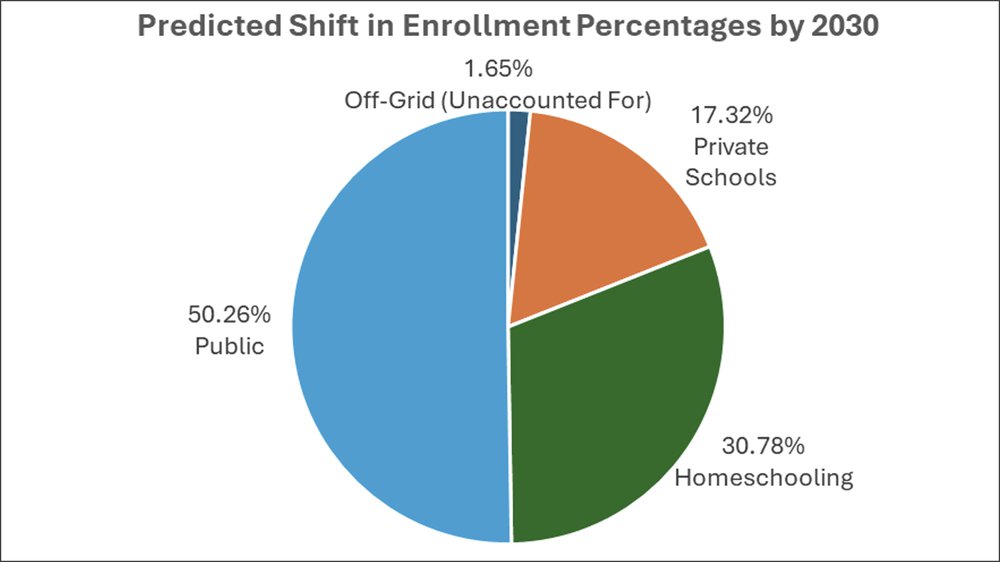
Source: The Learning Counsel
The Learning Counsel believes the biggest drivers away from public education are as follows:
- Choice legislation
- Remote preference
- Political/cultural preference which includes government distrust
- Rising violence and bullying in schools
- Immigration impacts
Whatever the reasoning may be for a parent removing their child(ren), it would behoove local, state, and federal officials to continue to address these concerns before more money is taken away from public schools. Not addressing these issues will further disadvantage the already disadvantaged, and if recent history has taught us anything, further dividing our country will likely have significant consequences.

